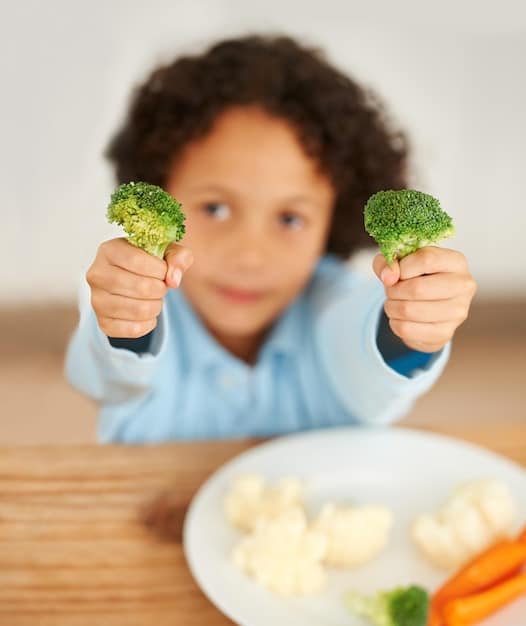The Ultimate Guide to Introducing Solids: First Foods and Schedules

Introducing solids is a significant milestone in your baby’s development, and this guide offers comprehensive advice on choosing first foods, understanding feeding schedules, and ensuring a smooth transition to solid foods.
Embarking on the journey of introducing your baby to solid foods is an exciting yet sometimes daunting experience. This the ultimate guide to introducing solids: first foods and feeding schedules for babies aims to provide you with a comprehensive resource to navigate this important milestone with confidence and ease.
When to Start Introducing Solids
Knowing when to start introducing solid foods to your baby is crucial for their health and development. It’s generally recommended to begin around 6 months of age, but every baby is different.
Signs of Readiness
Before rushing into introducing solids, look for key developmental signs that indicate your baby is ready. These signs are more important than simply reaching a certain age.
- Head Control: Your baby should be able to hold their head steady and upright.
- Sitting Upright: The ability to sit up with minimal support shows good core strength.
- Interest in Food: Does your baby watch you eat and reach for your food?
- Tongue-Thrust Reflex: The reflex to push food out of their mouth should be diminished.
If your baby exhibits these signs, it’s a good indication that they are ready to start exploring solid foods.
First Foods to Introduce
Choosing the right first foods for your baby is a frequently asked question among parents. The key is to start with simple, easily digestible options.

Single-Ingredient Purees
Begin with single-ingredient purees to identify any potential allergies. Introduce one new food every 3-5 days to monitor for reactions.
Recommended First Foods
Here are some excellent choices for your baby’s first foods:
- Avocado: Rich in healthy fats and easy to mash.
- Sweet Potato: Naturally sweet and packed with vitamins.
- Banana: Soft, easily digestible, and a good source of potassium.
- Peas: A great source of vitamins and fiber.
These foods are gentle on your baby’s digestive system and offer essential nutrients.
Creating a Feeding Schedule
Establishing a feeding schedule helps your baby adapt to solid foods and ensures they get the nutrients they need. Consistency is key, but flexibility is also important.
Sample Feeding Schedule
Here’s a sample schedule to guide you:
- 6 Months: Start with one meal a day, offering 1-2 tablespoons of pureed food.
- 7-8 Months: Gradually increase to two meals a day, offering a variety of fruits, vegetables, and proteins.
- 9-12 Months: Aim for three meals a day, incorporating finger foods and encouraging self-feeding.
Remember to adjust the schedule based on your baby’s appetite and cues. Observe their reactions and adapt as needed.
Finger Foods for Baby-Led Weaning
Baby-led weaning (BLW) is an approach where babies feed themselves from the start, skipping purees and going straight to finger foods. It encourages self-regulation and exploration of textures.
Safe Finger Food Options
When offering finger foods, ensure they are soft and easy to chew to prevent choking. Cut foods into small, manageable pieces.
- Soft-Cooked Vegetables: Steamed carrots, broccoli florets, and zucchini sticks.
- Soft Fruits: Ripe bananas, avocado slices, and cooked apple wedges.
- Cooked Pasta: Small pasta shapes like penne or macaroni.
Always supervise your baby during meal times and offer a variety of textures and flavors. This approach can help develop their fine motor skills and independence.

Addressing Allergies and Sensitivities
When introducing solids, being aware of potential allergies and sensitivities is important for your baby’s health. It is best to introduce common allergens early and often.
Common Allergens to Watch For
Some foods are more likely to cause allergic reactions.
- Cow’s Milk: Avoid giving cow’s milk as a main drink before 1 year of age.
- Eggs: Introduce cooked eggs in small amounts.
- Peanuts: Offer peanut butter or peanut flour in very small, diluted amounts.
- Tree Nuts: Introduce nut butters or flours cautiously.
How to Introduce Allergens Safely
Introduce potential allergens one at a time, waiting 3-5 days between each new food. Watch for signs of an allergic reaction, such as rash, hives, vomiting, or difficulty breathing. If you suspect an allergy, consult with your pediatrician.
Tips for a Successful Transition to Solids
Transitioning to solids can be a fun but sometimes challenging process. Here are some tips to help make it a positive experience for both you and your baby.
Create a Positive Mealtime Environment
Make mealtime enjoyable by creating a relaxed and positive atmosphere. Avoid distractions and focus on interacting with your baby.
Be Patient and Persistent
It may take multiple attempts for your baby to accept a new food. Don’t give up if they initially reject it. Offer the food again on different days.
Listen to Your Baby’s Cues
Pay attention to your baby’s hunger and fullness cues. Don’t force them to eat if they are not interested. Respect their appetite and adjust portions accordingly.
Summary
Introducing solids is a significant step in your baby’s growth. By following a well-planned approach, watching for readiness signs, and offering a variety of nutritious foods, you can set your baby up for a lifetime of healthy eating habits.
| Key Point | Brief Description |
|---|---|
| 👶 Readiness Signs | Look for head control, sitting ability, and interest in food. |
| 🍎 First Foods | Start with single-ingredient purees like avocado, sweet potato, or banana. |
| ⏰ Feeding Schedule | Gradually increase from one meal to three meals a day as they grow. |
| 🥄 Allergens | Introduce common allergens early and often, one at a time, watching for reactions. |
Frequently Asked Questions
▼
Most pediatricians recommend starting solids around 6 months old when your baby shows signs of readiness such as good head control and the ability to sit up.
▼
Good options include single-ingredient purees like avocado, banana, sweet potato, and peas. These are easy to digest and less likely to cause allergies.
▼
Introduce allergenic foods one at a time, waiting 3-5 days before introducing another new food. Monitor for any allergic reactions like rashes or vomiting.
▼
Start with 1-2 tablespoons of pureed food per feeding and gradually increase the amount as your baby gets older and shows more interest in eating.
▼
Don’t give up! It can take multiple attempts for a baby to accept a new food. Try again on different days and in different forms to encourage acceptance.
Conclusion
Introducing solids is a vital milestone in your baby’s growth, marking the beginning of their journey into the world of diverse flavors and textures. By understanding the readiness signs, following a gradual feeding schedule, and being mindful of potential allergies, you can confidently guide your little one towards a lifetime of healthy and happy eating habits, making mealtime an enjoyable and enriching experience for both of you.





